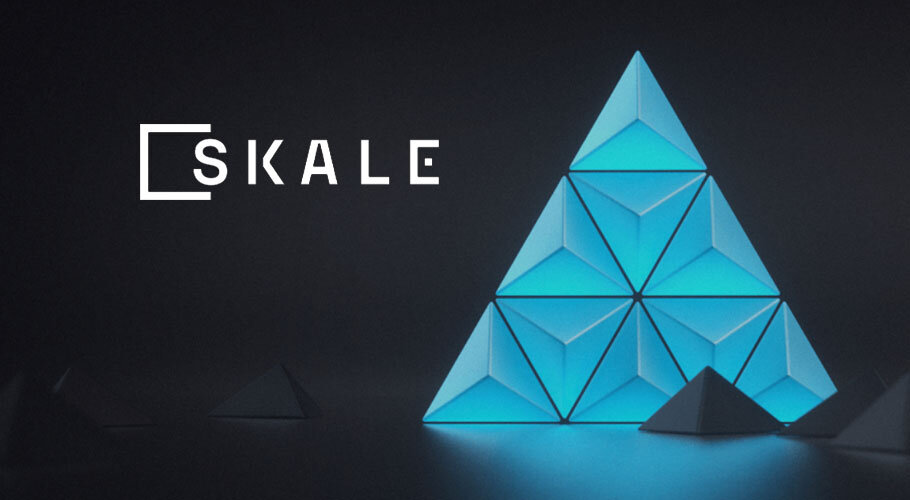Do you know SKALE and Ethereum are linked? NFTs token represents digital versions of artwork, music, and other items? It has already brought interest in Ethereum and the blockchain network where most NFTs are traded. Blockchains don’t have a central gatekeeper, such as a bank, to authenticate the transactions. Bitcoin and Ethereum keep a chronological record of transactions. We all know the cost of decentralization is high, and this cost is the computer’s power. Let’s get into this blog to learn which blockchain challenge is SKALE helping the Ethereum ecosystem overcome? Read on!
What is SKALE Network?

Elastic sidechains are integrated with the Ethereum platform, allowing users to define the security protocols. Potential Dapp developer adjusts the parameters for side chains by selecting the desired chain size, virtual machine, and parent blockchain.
SKALE management automatically assigns 16 virtualized sub-nodes and fractional core nodes. Users can adjust the settings for their Dapps by choosing the correct parent blockchain and security protocol. It helps the Ethereum ecosystem by providing low-cost services and tools to developers. We aim to promote decentralization and the widespread use of blockchain systems.
SKALE network uses a validation model to provide a secure way to validate transactions and tokens. The network provides backward compatibility with ERC-20 platforms. It allows delegators to use secure keys and store tokens in the wallet of their choice. The Ethereum ecosystem is facing a crucial challenge. It needs to scale up, or it will fade into obscurity.
Why SKALE Network Is A Blockchain Challenge?
SKALE network is a multichain platform that allows Dapps to store files on the blockchain for no fee. It will enable developers to minimize the number of information moves and transaction fees. SKALE allows blockchain to improve faster. It uses instant finality to prevent time-bandit attacks.
SKALE manager uses and overall 16 peer metrics. The top four statistics are removed to prevent malicious peer nodes from affecting the network. SKALE network is an elastic sidechain network built on the Ethereum platform. It connects the Ethereum network to other decentralized networks through sidechains.
SKALE network is an open source that provides speed and decentralization to the blockchain. This network also allows Dapps to interact more efficiently with blockchain. By working with Ethereum, SKALE networks have geared up for minimizing the costs and improving transaction speed by offering developers Dapp specific SKALE blockchains.
SKALE network has drawn the attention of several well-known business platforms. These applications range from games to decentralized finance. List of ecosystem partners continues to grow. It’s essential that we continue to build the community.
Does SKALE Network Reduce Congestion?
SKALE network uses nodes to process Ethereum transactions. These nodes are made up of node core and sub-nodes. They run an Ethereum virtual machine and enable inter chain communication.
SKALE has ability to run multiple side chains on same network. It allows developers to use a sub chain that is best suited for their needs. SKALE helps to speed up transactions and reduce congestion in the Ethereum ecosystem. It provides elasticity to the network and participates in the consensus mechanism.
SKALE’s multichain architecture is built on Ethereum. It allows for faster transactions. This will enable developers to use a sub-chain best suited to their needs. They can adjust the size, parent blockchain, protocols, and security measures of each side chain. It helps to speed up transactions and reduce congestion in the Ethereum ecosystem.
SKALE is an open-source, decentralized elastic blockchain network based on Ethereum. Its architecture allows it to scale along with the growth of web3 and is highly flexible.
SKALE Address The Security And Privacy Concerns
SKALE network is based on blockchain technology, which means data on the network is accessible publically. This enterprise application using SKALE networking addresses security and privacy concerns. It requires security and privacy to be effective and remain secure. It has distributed computing model called validator nodes. Developers can access the compute power of these nodes to build Dapps. They must integrate SKALE with scaling solutions.
SKALE network uses proof of stake cryptography to verify transaction chains. Token holders can delegate the tokens to a validator on the network. This ensures that a small set of nodes will not be compromised. Blockchain remains secure, and validator nodes meet certain technical specifications. It includes high performance and low latency.
Which Model is used by SKALE Network?
SKALE network uses a subscription model that offers Dapp developers a highly scalable infrastructure compatible with the Ethereum platform. Developers can deploy Dapps on the Ethereum network without experiencing challenges or delays. SKALE network allows users to create customized sidechain specifications to improve performance and decrease transaction fees. Sidechains can be adapted to meet the needs of different Dapps. They can be sized and connected and have various protocols and security measures.
Developers can use sidechains to test and deploy Dapps and links them to the main chain. SKALE offers a subscription model that enables users to pay for specific services and applications with low fees. SKALE network is designed for Ethereum and works with Ethereum protocols. It is ideal for creating Dapps. SKALE is used for linear scaling. Virtualized sub-nodes can be added to the system to generate new chains and increase capacity. SKALE network uses a subscription model for validators. SKL tokens are kept in an Ethereum smart contract that monitors and distributes payments monthly.
Final Thoughts
If you were searching for which blockchain challenge SKALE is helping the Ethereum ecosystem overcome? These are the few challenges we have mentioned to help the Ethereum ecosystem overcome. The transition of Ethereum to proof of stake has required massive efforts. Although smart contracts are in use on the Ethereum blockchain, which has put billions of dollars worth of assets at risk.

